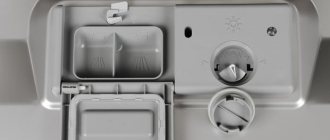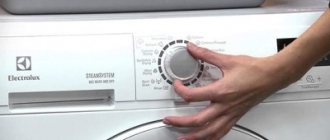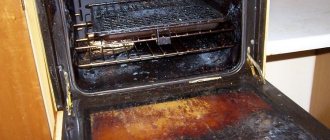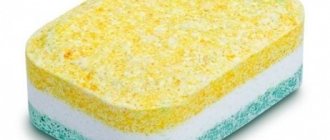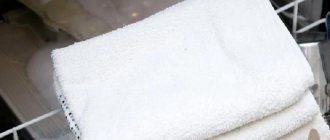Household appliances can make housekeeping much easier. With its help, the time spent on keeping your home clean, cooking or caring for things is greatly reduced, and work efficiency also increases. Housewives spend a lot of time in the kitchen. Washing dishes usually takes a lot of effort and is not a pleasant process. Dishwashing units allow cooks to be relieved of this responsibility. The machine will last for a long time if used correctly.
How to use a dishwasher
Types of dishwashers
The equipment can be used for industrial purposes or in private households. We will talk about household devices.
Types of dishwashers
Dishwashing machines can be classified according to several criteria.
Installation method
The most primitive unit, suitable for small kitchens and small families, is a compact household appliance that can be installed on a table (which is more common) or on the floor. With its help, the problem of washing a moderate amount of dirty dishes, determined by the capacity of the model, is solved. If desired, the dishwasher can also be placed in a hanging cabinet. And its mobility and compact size make it possible, if necessary, to take it, for example, to the dacha.
Countertop dishwasher
A mini dishwasher is not inferior in functionality to full-size models
In spacious rooms it is possible to install a free-standing dishwasher. This is relevant if you cannot integrate the car into the headset. The big advantage of such devices is the possibility of rearrangement and easy access to components for maintenance.
Freestanding dishwasher
Built-in appliances are usually installed in a cabinet under a countertop. In this case, you can leave the unit open or disguise the equipment with a closing cabinet door. In this case, the set looks more holistic and aesthetically pleasing.
Built-in dishwasher
Such models fit harmoniously into interiors; their installation does not require significant free space. However, the process of carrying out repair work is significantly complicated.
Dimensions
The machines offered by manufacturers can be divided into three categories.
- Wide.
- Narrow.
- Compact.
The first group includes full-size units with a height of 820...870 mm, a width of 600 mm and a depth of 550 or 600 mm. The capacity of the models allows you to process up to 17 sets of dishes at one time.
Separately from this class we can distinguish combined units, which are becoming increasingly popular. This design combines several appliances: a dishwasher with an oven and a hob (gas or electric). This equipment greatly simplifies the owner’s work, however, if one of the modules breaks down and you need to contact the service department, you can be left for some time without a whole range of necessary equipment.
Dishwasher with oven and stove - 3 in 1
Narrow devices differ from the first category only in width. It varies from 445 to 490 mm.
Narrow dishwasher
Compact dishwashers, which are optimal for installation in small apartments, have a smaller height (440...600 mm). Their width can be from 500 to 600 mm, and their depth - from 500 to 550 mm.
When choosing a model, it is important to take into account the lifestyle (where household members eat: outside the home or during family lunches and dinners) and family composition. The loading capacity of a dishwasher is determined by the number of sets that can be processed simultaneously. The set includes: plates for the first and second courses, cup, saucer, knife with fork and spoon.
Wide dishwasher
Table. The loading capacity of the machine corresponds to the number of household members.
| Number of family members, people | Simultaneous loading, sets |
| 5 — 6 |
| 8 — 10 |
| From 11 |
Classes
In accordance with the characteristics of the equipment, it is assigned a certain class. This refers to the most important parameters.
Dishwasher Energy Efficiency
Decoding the sticker
Cleaning
The quality of dishwashing can be assessed by the cleaning class:
- A - the highest level of purity.
- B, C - minor contamination is allowed on washed kitchen utensils.
It is unlikely that anyone would want to have equipment at home that has a class other than A.
Water consumption
Water consumption per wash is also a significant characteristic. Class A cars consume approximately 10 liters, B - around 20 liters, C - over 25 liters.
Comparative table of the amount of water consumed depending on the brand and load of the dishwasher
Electricity consumption
Due to the fact that the cycle time of a dishwasher can sometimes exceed two hours, the energy consumption characteristics of the machine cannot but be considered important. The main part of the energy costs is for heating the water, as well as for the drying process.
During testing, equipment is assigned classes, which are marked with letters from A to G. Today, manufacturers mainly offer fairly economical models of classes A and B.
Table. Comparison of energy consumption of dishwashers of different classes.
| Unit marking | Electrical energy consumption for 1 cycle, kW/h |
| A | 0,8…1,05 |
| IN | 1,06…1,09 |
| WITH | 1,1…1,49 |
Many devices operate even more economically. Their classes are designated as “A+”, “A++” and “A+++”.
Dishwasher class A++
Important! Seemingly economical compact devices often cannot be fully classified in this category, since compared to their full-size counterparts they require a greater number of cycles to wash the same number of sets.
What should you pay attention to when choosing technology?
When choosing the optimal machine model, it is important to take the time to study the capabilities and characteristics of the offered equipment. In addition to class, size and installation method, several other aspects matter.
The material from which the tank, rocker arms and baskets are made affects the durability of the units. It is important that as few parts and assemblies are made of plastic.
The capabilities of the technology and its contents are also important to the user. Various modes allow you to better cope with the task. For example, the “soaking” mode helps to more effectively wash off dried dirt.
Dishwasher washing modes are described in the instructions
An installed system for determining the degree of water purity is necessary for the control unit to make a decision about draining the water or reusing it. Built-in drying is also very useful for owners. In everyday life, it is convenient to wash dishes with a half load.
Dishwasher Whirlpool ADPF 851 WH
Models are available with mechanical or electronic control. Most modern equipment is equipped with the second option, although it is considered less reliable.
BEKO DSFN 6530 dishwasher control panel
The noise level produced by a running unit is often of great importance. Especially for families with small children. It can vary in the range of 38...55 dB. To prevent the machine from causing inconvenience, it is better if the indicator does not exceed 45 dB.
The reliability of equipment is largely determined by the country of manufacture and manufacturers. Products manufactured by Miele, Electrolux, Bosch or AEG have long been proven for their quality.
Video - Electrolux ESF45055XR dishwasher
Of course, these brands cost a lot. Italian technology also performs well.
Italian kitchen appliances Smeg
Many people are suspicious of the products of Chinese factories, but recently decent models can be found in this segment.
Xiaomi smart dishwasher
Components of a commercial rinse aid
If you can calculate the required amount of factory-made product, then you will have the opportunity to save a lot of money, but you can spend even less money if you manage to prepare a very effective rinse aid yourself. In order to create a similar product yourself, it is necessary to at least approximately know what substances and in what dosage are included in the factory rinse aid. Different manufacturers and different brands still use the same or identical components as a basis. All rinses contain:
- surfactants - non-ionic;
- anionic polymers of the carboxyl type (they can also be called polycarbonates);
- citric acid, which is found in any home;
- tensides, as well as a small amount of ethanol.
Thus, it is quite possible to prepare a rinse at home, because the components in its composition are easily available. Of course, in addition to the above ingredients, there are others that are not available to us, but even without them you can create an excellent budget substitute for an expensive branded mouthwash.
Connection recommendations
It is quite possible to carry out the work on installing and preparing for operation a machine, especially a free-standing one, yourself.
If the equipment was purchased during the cold period, you cannot immediately connect it. The machine (the protective film can be removed) must stand at room temperature so that it can heat up and the condensation that has formed will disappear.
Brief instructions for connecting equipment.
Step 1.
Electrical work. You will have to run a separate power supply line directly from the panel.
To connect the device to a 220 V network, you will not need many materials and devices: a VVGnG-Ls cable 3 * 2.5 mm2, a power socket with grounding, a differential circuit breaker for 16 A or 25 A.
Power socket with grounding
Differential automatic
It is important to choose the right place to install the outlet. It is recommended to mount it at a height of 90 cm from the floor (this makes it more convenient to use). The device must not be located behind the connected machine.
Connection diagram of the dishwasher to communications
It should also be taken into account that the length of the cord of kitchen equipment usually does not exceed 1.5 m. Extension cords should not be used.
Step 2.
Connection to sewerage. The standard siphon located under the sink should be replaced with a new one - with an additional fitting. The drain pipe of the machine will be connected to it. Universal models are recommended - with fittings for connecting both dishwashers and washing equipment.
An example of organizing water drainage from a dishwasher through a siphon under the kitchen sink
Step 3.
Connection to water supply. A tee with a ¾-inch thread is installed at the connection point of the kitchen faucet. It is screwed to the pipe supplying cold water.
Connecting the dishwasher to the water supply and sewerage
The water supply pipe to the dishwashing unit is connected to the water supply through a shut-off valve, filter and pressure gauge (as recommended by equipment manufacturers).
Many models are adapted for connection to hot water supply. This method allows you to save a little on electricity. However, hot water contains more impurities, which can lead to premature failure of equipment.
Video - Installing a dishwasher
Step 4.
The position of the machine (level) should be adjusted using the support legs.
Adjusting the dishwasher support legs
Another photo of the process.
Fixation to the base (when installed in a cabinet) is done using fastening clamps.
Step 5.
A test run is being carried out. The shut-off valve on the tee opens. The machine turns on for a short cycle in idle mode. It is recommended to use detergent. During the test run, grease and dirt are removed. All connections are checked for leaks, and hoses are checked for kinks.
To start the dishwasher for the first time, you can use a special product.
Using the dishwasher for the first time
Important! The unit should not be installed close to a wall, otherwise the supply and drain hoses may become pinched.
Malfunctions and their elimination
If a household appliance is not working, you need to inspect it. Breakdowns often occur due to the fact that the grilles and filters become clogged with food debris.
Household appliances do not turn on if the power supply is low.
If the dishwasher stops while running, it may be due to a water leak. You should check whether the machine is installed level. If not, the water will overflow the edge of the container.
Stoppage is possible if a lot of detergent is loaded into the compartment. This causes excess foam to form.
The equipment does not work if there are problems with the water sensor. It accumulates in excess, so the dishwasher turns off.
If the machine does not drain water, there may be a clog. If the inspection fails to determine the cause of the breakdown, you should contact the service center.
Dishwasher operating instructions
How are dishes washed in the unit? The operating principle of equipment from different manufacturers differs little. The difference may only lie in the additional capabilities of individual models. The working process is started by the engine. All operations are regulated by electronics. Using a pump, water is supplied to rotating rocker arms with nozzles. From there it falls onto dishes placed in grids. Strong pressure allows you to clean dirt from kitchen utensils. The water then passes through a filter where it is purified for reuse or disposed of. For this purpose, a drainage system is installed: a pump, a pipe and a hose.
Dishwasher inside
Heating of water to the required temperature is carried out by a heating element. Cleaning dishes from dirt occurs in a multi-stage process. Pre-soaking is used to treat heavily soiled products. After this, the water is heated and the main part of the process begins. Jets of water mixed with detergents wash the dishes under pressure.
Jets of water in a car
After cleaning from dirt is completed, the control unit switches the machine to rinsing mode. For this purpose, a special agent can be added.
Drying completes the machine's operating cycle. It can be carried out using condensation, or a stream of hot air. Not long ago, turbo drying began to be used.
Video - What happens in the dishwasher
Regular Maintenance Rules
Not only filters, but also chamber walls, sprinklers, and compartments of loading baskets can be damaged by dirt. The simplest thing the user can do is to manually wipe all parts with a damp cloth using a light cleaning solution from time to time.
You can make the maintenance process easier by using a sprayer. Mix water with dishwashing detergent, pour into a bottle, apply to all elements inside the washing chamber, then wipe
Preventive dry cleaning of the dishwasher will help protect internal parts from the appearance of mold, greasy deposits or other dirt.
Work order:
- empty all boxes of dishes;
- Fill the powder cuvette with a special dishwasher cleaner;
- select one of the long programs, for example, “standard”.
The water temperature during washing should be above +60 °C so that the cleaning agents are as effective as possible and all contaminants are dissolved and washed down the drain. It is recommended to practice dry cleaning at least once every 4-6 months.
The door is usually wiped manually, carefully treating not only the front glass, but also the seals.
The AquaStop system installed on the inlet hose prevents leaks and protects the machine from accidents. The hose, along with the valve and filters, is removed and also carefully cleaned of debris.
In order for the drainage system to work properly, you also need to rinse the drainage hose. It is unscrewed, rinsed with anti-grease detergents and fixed in place.
When returning all parts to their places, it is necessary to tighten the union nuts tightly and check the tightness of the connections before turning on. If the work is not done carefully, a small flood is possible during washing.
How to wash dishes
The process begins with preparation. Contaminated dishes are placed in the basket sections.
How to load pans and large dishes into the dishwasher
Loading the dishwasher
Chemical cleaning agents should be poured or poured into the compartments specially designed for this purpose.
When loading the dishwasher, each individual detergent is poured into its own special compartment.
The appropriate mode for processing dishes is selected on the touch panel or using the knobs. The device is ready for use. This is where the hosts' participation ends. The machine performs all other procedures itself.
Dishwasher control panel
When the dishwasher finishes its work, an alarm sounds. Clean kitchen utensils can be removed.
Unloading the dishwasher
Some nuances in using the unit
When using dishwashers, you should follow some rules.
Large items are placed on the lower level: frying pans, pots, large dishes.
An example of the correct placement of large dishes in the dishwasher tray for washing
The upper basket is designed for washing small utensils and fragile dishes.
It is important to provide a distance between the mugs and plates so that the water jets can treat them from all sides. Knives, spoons and forks are placed in a tray specially designed for them. Glasses and cups are placed bottom up.
Securing stemmed crystal glasses in the dishwasher
Important! Residues of food must be removed from the dishes before loading.
High water pressure and temperature impose restrictions on the ability to process certain types of dishes:
- without heat-resistant coating;
- made from plastic that is not machine washable;
- made of metal not protected from corrosion;
- tin, copper and wooden objects;
- decorated with hand painting.
An important question that arises when operating a machine is what cleaning products are used. They can be in the form of: powder, tablets or gel. Thanks to chemistry, dishes are effectively cleaned from dirt and grease. A special liquid is also added for rinsing.
Dishwasher detergents
In addition to detergents, you should use salt to soften the water. Thanks to it, scale and other deposits will not be able to form on the parts.
Manufacturers also produce products in the form of 3-in-1 tablets. When using them, there is no need for salt and rinse aid.
Dishwasher tablets


